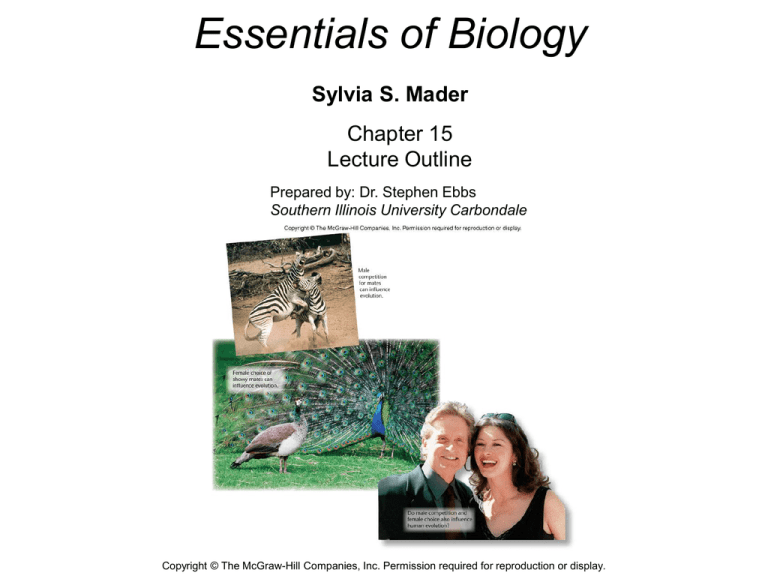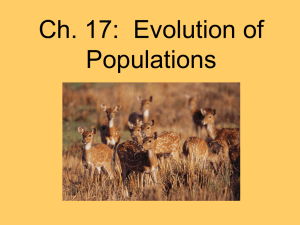Chapter 15
advertisement

Essentials of Biology Sylvia S. Mader Chapter 15 Lecture Outline Prepared by: Dr. Stephen Ebbs Southern Illinois University Carbondale Copyright © The McGraw-Hill Companies, Inc. Permission required for reproduction or display. 15.1 Microevolution • A population is defined as all the members of a single species occupying a particular area and reproducing with one another. • Microevolution involves the evolutionary changes within a population. • While variation within a population is important to evolution, it is not the only factor. 15.1 Microevolution (cont.) 15.1 Microevolution (cont.) Evolution in a Genetic Context • Evolution at the population level can be studied using population genetics. • In population genetics, the various alleles at all the gene loci in all the individuals make up the gene pool of that population. • The gene pool of a population can be described in terms of gene frequencies. Evolution in a Genetic Context (cont.) • Consider the following example for a population of 100 Drosophila fruit flies. – 36% of flies are homozygous dominant for long (L) wings (36 flies) – 16% are homozygous recessive for short (l) wings (16 flies) – 48% are heterozgous (48 flies) Evolution in a Genetic Context (cont.) • So how many L and l alleles are in the population? Number of L alleles Number of l alleles LL (2 L x 36) = 72 LL (0 l) = 0 Ll (1 L x 48) = 48 Ll (1 l x 48) = 48 ll = 0 ll = 32 (0 L) 120 L (2 l x 16) 80 l Evolution in a Genetic Context (cont.) • To determine the frequency of an allele in the population, calculate the percentage of that allele from the total number of alleles in the population. • For the dominant allele, L = 120/200 = 0.6 • For the recessive allele, l = 80/200 = 0.4 Evolution in a Genetic Context (cont.) • These percentages represent the frequency of each allele in the gametes of this population. • If the mating in this population is assumed to be random, then the genotypes in the subsequent generation can be determined using a Punnett square. Evolution in a Genetic Context (cont.) • In this Punnett square, the cross indicates the possible alleles contributed by the population, not an individual. sperm 0.6 L 0.4 l 0.6 L 0.36 LL 0.24 Ll 0.4 l 0.16 ll eggs 0.24 Ll Genotype frequencies 0.36 LL + 0.48 Ll + 0.16 ll • Note that the frequencies of L and l remain the same in the subsequent generation. Evolution in a Genetic Context (cont.) • Hardy-Weinberg equilibrium is expressed as a simple binomial equation. p2 + 2 pq + q2 • The letters p and q are used to represent the frequency of the two alleles in the population. Evolution in a Genetic Context (cont.) Evolution in a Genetic Context (cont.) Evolution in a Genetic Context (cont.) • Hardy-Weinberg equilibrium is maintained in a population of sexual reproducing individuals if five conditions are met. – No net change in frequency due to mutations – No gene flow (migration of alleles in or out of the population) – Random mating must occur – No genetic drift – No natural selection Evolution in a Genetic Context (cont.) • These conditions are rarely if ever met in the real world. • Thus allele frequencies continually change and microevolution occurs. • The value of the Hardy-Weinberg principle is that it describes the factors that cause evolution. Evolution in a Genetic Context (cont.) • In order for natural selection to act on allele frequencies, the change must affect the phenotype associated with the gene. • A classic example of microevolution is industrial melanism. Evolution in a Genetic Context (cont.) Evolution in a Genetic Context (cont.) Causes of Microevolution • Deviations from the conditions of HardyWeinberg equilibrium cause the allelic changes associated with microevolution. – Mutations – Gene flow – Nonrandom mating – Genetic drift – Natural selection Genetic Mutations • Mutations are the raw material of evolutionary change. • Mutation introduces new variation into a population. • This variation is adaptive if it helps members of a population adjust to specific environmental conditions. Gene Flow • Gene flow, or gene migration, occurs when breeding members of a population leave a population or new members enter. • Gene migration can introduce new alleles to populations. • However continual gene flow between populations decreases differences in allele frequencies, preventing speciation. Gene Flow (cont.) Nonrandom Mating • When males and females reproduce together strictly by chance it is called random mating. • Any behavioral activity that fosters the selection of specific mates is nonrandom mating. – Assortive mating occurs when organisms select mates with a similar phenotype. – Sexual selection favors traits that increase the likelihood of securing a mate. Genetic Drift • Chance events that cause the allele frequency to change is called genetic drift. • The effect of genetic drift becomes increasingly important as the size of the population decreases. Genetic Drift (cont.) Genetic Drift (cont.) • Another example of genetic drift is the bottleneck effect. • A bottleneck occurs when an event or a catastrophe drastically reduces the number of organisms in a population. • The variation in that population may also be reduced, changing the allele frequencies within the population. Genetic Drift (cont.) Genetic Drift (cont.) • The founder effect is another example of genetic drift. • The founder effect occurs when combinations of alleles occur at a higher frequency in a population that has been isolated from a larger population. Genetic Drift (cont.) 15.2 Natural Selection • Natural selection is the process that adapts populations to the environment. • Some aspects of the environment can involve biotic (living) components. – Competition for limiting resources – Predation – Parasitism 15.2 Natural Selection (cont.) • Some aspects of the environment can involve abiotic (nonliving) components. – Weather and climate – Temperature – Moisture 15.2 Natural Selection (cont.) Types of Selection • The variation within a population creates different phenotypes for a given trait. • The distribution of those phenotypes typically forms a normal distribution. • The effect of the three types of natural selection have different effects on this normal distribution. Directional Selection • When one extreme phenotype is favored by natural selection, the distribution of the phenotype shifts in that direction. • This type of selection is therefore called directional selection. Directional Selection (cont.) Directional Selection (cont.) Stabilizing Selection • Stabilizing selection occurs when the intermediate, or most common, phenotype is favored. • This type of selection tends to narrow the variation in the phenotype over time. • This is the most common type of selection because it is associated with the adaptation of an organism to the environment. Stabilizing Selection (cont.) Disruptive Selection • In disruptive selection, natural selection acts upon both extremes of the phenotype. • This creates a increasing division within the population which may ultimately lead to two different phenotypes. • Disruptive selection is the process that leads to speciation. Disruptive Selection (cont.) Disruptive Selection (cont.) Maintenance of Variations • The preservation of variation in a population is important because it provides a foundation on which natural selection can act. • Variation is preserved by a variety of processes. – – – – – Mutations and genetic recombination Gene flow Natural selection Polymorphisms (differences in form) Diploidy and the heterozygotes Diploidy and the Heterozygote • Natural selection can only cause evolution if the different alleles produce different phenotypes. • Because many organisms are diploid, heterozygotes are carriers of recessive alleles, preserving them in the population. • This also creates another phenotype that may contribute to ratio of balanced polymorphisms. Diploidy and the Heterozygote (cont.) • Sickle cell disease is an example of balanced polymorphism. • Under normal conditions, the different phenotypes provide different fitness levels. – HbSHbS genotypes suffer from sickle cell and usually die young. – HbAHbA genotypes are normal and usually the most fit. – HbAHbS genotypes are affected by sickle cell disease only when oxygen levels are low. Diploidy and the Heterozygote (cont.) • Surprisingly, the recessive allele (HbS) occurs at a higher than expected frequency in regions where malaria is present, such as in Africa. • This occurs because the heterozygote phenotype is favored under these conditions and homozygotes are selected against. Diploidy and the Heterozygote (cont.) Diploidy and the Heterozygote (cont.)








